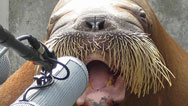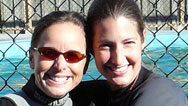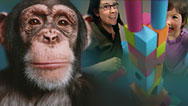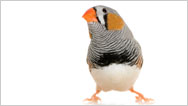
Smart Marine Mammals
Marine mammals are wowing researchers with more than just circus tricks. Airing July 21, 2009 at 9 pm on PBS Aired July 21, 2009 on PBS
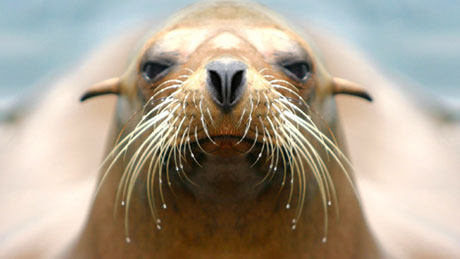
Program Description
Transcript
Smart Sea Lions And Talking Walruses
PBS Airdate: July 21, 2009
NEIL DeGRASSE TYSON: Class, we know that some animals can learn to do all kinds of entertaining tricks. But now we're finding out that some creatures can learn and even reason in a way that's totally unexpected.
Correspondent Ziya Tong had a close encounter with a group of animals who not only go to school, they study and they're actually acing their tests!
Class!! Class!!!
Thank you.
LEAH COOMBS: Okay, Ziya come on in.
ZIYA TONG: I'm so excited.
Okay, so this was an offer I couldn't refuse...
LEAH COOMBS: Come around this way, Ziya.
ZIYA TONG: My God, what did I get myself into?
I've flown across the country for a kiss, a kiss from a walrus—all 2,300 pounds of him.
His name is Sivuqaq, and he and two females live here at a Six Flags Amusement Park in Vallejo, California. They were found abandoned in Alaska, when they were only two weeks old.
LEAH COOMBS: So here's their food.
ZIYA TONG: Leah Coombs is their trainer.
LEAH COOMBS: Do you want to grab a handful out of there?
ZIYA TONG: Uggh.
LEAH COOMBS: Are you ready?
ZIYA TONG: I think so.
This is certainly a long way to come for a kiss.
Wow.
LEAH COOMBS: So, this is Siku, right here, one of the girls.
ZIYA TONG: Hello, Siku.
And now, seeing their size, I wonder if it was such a good idea.
LEAH COOMBS: You want to give her a kiss? Give her a kiss on her cheek. Siku, target.
So lean in to her so she can get to you.
Target. Good girl. Kiss. Okay. Good girl. Blow a kiss.
ZIYA TONG: All my fears aside, these guys really know how to impress a gal.
Sit up.
Oh, get out of town! Get out of town.
As charming and funny as these characters are, some scientists say these clowns are challenging long-held assumptions about what makes humans different from other animals.
I never thought you could be so friendly.
LEAH COOMBS: Good girl. Give me a sound. Good.
ZIYA TONG: And that is what Colleen Reichmuth and Ron Schusterman study. They're trying to understand the behavior and intelligence of these marine animals and others, like seals and sea lions, that all belong to a family of fin-footed mammals called pinnipeds.
At their lab, at the University of California, Santa Cruz, they and their students work to understand the how these animals' brains function. And to do so, they run the lab much like a school for pinnipeds.
Meet the class star, Rio, a California sea lion. Definitely entertaining, but no academic slouch either.
COLLEEN REICHMUTH: Rio's really a remarkable animal. She's had about 21 years of schooling.
ZIYA TONG: Rio has some pretty remarkable classmates, too, including Sprouts, a harbor seal...
COLLEEN REICHMUTH: Speak.
SPROUTS (A Harbor Seal): Wowowowowo.
ZIYA TONG: ...and a half-ton Northern elephant seal, named Burnyce.
COLLEEN REICHMUTH: Here you go. Good. Down.
ZIYA TONG: At this would-be-school, the animals spend their days taking tests.
COLLEEN REICHMUTH: Sea lions can pass tests that are very difficult for many other species to pass, including some of the great apes and including humans.
ZIYA TONG: Here's how it works. Rio, like a participant at a game show, sits in front of a wood set and is shown different characters, some that look like numbers, some like letters.
Rio has been taught that certain sounds, like crickets, go with a particular number or letter, like D.
So, when the buzzer sounds, she selects her answer by pointing her nose at one of the cards. If she makes the right match, she gets a fish.
Rio loves getting fish rewards and memorized very quickly that particular sounds go with particular letters or numbers. For instance, the ring of a telephone goes with B.
COLLEEN REICHMUTH: So, Rio could learn, by trial and error, that straightforward rote memorization that if she hears the ring, then she should always choose B. And she's able to make that type of association very quickly.
ZIYA TONG: Sea lions like Rio are perfect for this kind of testing because they are like, well, a dog with bone.
COLLEEN REICHMUTH: Sea lions can be very focused. They can ignore lots of other distractions, and really home in. When Rio makes an error, you may see her kind of tense up, jump in the pool, swim around. She may bark. She'll pace around a little bit. She's a bit intense.
ZIYA TONG: As any student knows, rote memorization is a useful skill in taking tests for a sea lion or a human, but it isn't all that impressive when it comes to demonstrating intelligence.
But today's test is.
COLLEEN REICHMUTH: This is J, as in jack, on the right; number 9, on the left.
ZIYA TONG: Colleen wants to see if Rio can exhibit that supremely human skill of logic.
COLLEEN REICHMUTH: So Rio had previously learned that A, B and C, that all letters could be grouped together. And now, she learned something new: that ring goes with B.
ZIYA TONG: So today, Rio is presented with a new problem. She hears the familiar ring sound, but her choices are only the letter C and the number 9, not B the answer she has been taught. Now Rio must figure out what answer will get her a fish. Very quickly, she figures out that she can substitute B with any other letter.
COLLEEN REICHMUTH: It turns out that Rio is able to use a logic rule to solve a problem that you haven't encountered before, being able to, you know, think it through and be correct on your first exposure.
ZIYA TONG: Rio scores over 90 percent on this exam, definitely an A student.
It was through experiments like this that Rio became one of the first animals to demonstrate a kind of higher order reasoning once thought limited to humans. And this kind of reasoning is also believed to be the basis for the most human of intellectual expressions: language.
So how does this research relate to the evolution of human language?
RONALD J. SCHUSTERMAN (University of California, Santa Cruz, Long Marine Laboratory): Symbols have meaning. They stand for something else. Many experiments now suggest that different types of animals have an understanding of meaning. They can comprehend the use of symbols.
COLLEEN REICHMUTH: You can make the analogy to the way we use sounds to identify certain objects in our environment. For example we use the word "car" to identify a physical shape that is a car.
ZIYA TONG: Another aspect of Reichmuth and Schusterman's research is to see if these animals can be taught to control the sounds they make, like humans do when we learn to speak. That is where our one-ton walrus friends come in.
SIVUQAQ: Ohhhhhhhhh.
ZIYA TONG: Most mammals make particular sounds only in reaction to a specific situation, like a dog that growls when it's threatened. Efforts to train apes and other land-dwelling mammals to control and modify the sounds they make have largely been unsuccessful.
LEAH COOMBS: Knock. Good. Knock, knock. Good.
ZIYA TONG: A lot of animals obviously communicate through sound, so what's different about a walrus?
RONALD J. SCHUSTERMAN: What this training shows is they have incredible control over this, so that they can learn to produce these under certain occasions and inhibit them under other occasions.
LEAH COOMBS: Give me a sound, something else, now.
COLLEEN REICHMUTH: Certainly language is very special. You know, people have always looked for reasons to separate animals from humans. Some people will tell you it's because humans have a soul, some people will tell you it's because humans have language. From my experiences studying animals, I can't point to any one feature that sets humans apart from non-human animals. The distinctions are blurred.
ZIYA TONG: Through the rigors of higher education, it seems that animals like Sivuqaq, Rio and Sprouts, are capable of surprising intellectual feats...
Oh, you deserved this one. You worked extra hard.
...and that suggests that many of the skills we considered to be uniquely human, just might not be.
On Screen Text: So Rio was able to figure this out: if greater-than is greater than B, and B is greater than C, then greater-than is greater than C. At what age is a human able to do this? 6 months? No. One year? No. Two years? No. Four years?
If greater-than is greater than B, and B is greater than C, then greater-than is greater than C.
It isn't until about four years of age that humans are able to make the associations that Rio made.
Broadcast Credits
Smart Sea Lions And Talking Walruses
- Edited by
- Jedd Ehrmann
- Written, Produced and Directed by
- Terri Randall
NOVA scienceNOW
- Executive Producer
- Samuel Fine
- Executive Editor
- Neil deGrasse Tyson
- Senior Series Producer
- Vincent Liota
- Senior Producer
- Julia Cort
- Supervising Producers
- Stephen Sweigart
Joey David Jovanovich - Senior Editor and Colorist
- David Chmura
- Online Editor
- Laura Raimondo
- Senior Researcher
- Sharon Kay
- Associate Producer
- Fran Laks
- Assistant Editors
- Rob Chapman
Tung-Jen (Sunny) Chiang - Graphic Design
- Brian Edgerton
- Compositor & Animator
- Yunsik Noh
- Music
- Rob Morsberger
- Sound Mix
- Bill Cavanaugh, RazorMix, Inc.
- Assistant to Neil deGrasse Tyson
- Elizabeth Stachow
- NOVA scienceNOW Series Animation
- Edgeworx
- Field Producer for Sea Lions segment
- Solana Pyne
- Associate Producers
- Heeth Grantham
Jeff Marion
Laura Willcox - Camera
- Steve Baum
Joe Brunette
Austin de Besche
Dan Krauss
Jon Shenk - Sound Recordists
-
Fred Burnham
Jim Choi
Michael Cottrell
Doug Dunderdale
Charlie Macarone
Claudio Musajo - Animation
- Anthony Kraus
399 Productions - Production Manager for Picky Eaters segment
- Michael Reichman
- For Lone Wolf Documentary Group
-
- Executive Producer
- Kirk Wolfinger
- Production Manager
- Donna Huttemann
- Archival Material
- Corbis
Wiley-VCH. Small 2009, pp. 694-700 - Special Thanks
- Bright Horizons Family Solutions
Phil Darrell
John Glendinning
Christopher Graves
Icelandic Tourist Board
Liz Jones
Sue Kangiser
Maryam M. Khani
Sam Krevor
Kristy Lindemann-Biolsi
Microsystems Technology Laboratory at MIT
Petqua
Peter Renee
Jagesh Shah
South Mountain YMCA Child Care Center
StatoilHydro
Leslie J. Stein
Scott Stein and the Springside School
Tucson 12
Jennifer Wade
Hans Ziock - Neil deGrasse Tyson
- is director of the Hayden Planetarium in the Rose Center for Earth and Space at the American Museum of Natural History.
- NOVA Series Graphics
- yU + co.
- NOVA Theme Music
- Walter Werzowa
John Luker
Musikvergnuegen, Inc. - Additional NOVA Theme Music
- Ray Loring
Rob Morsberger - Post Production Online Editor
- Spencer Gentry
- Closed Captioning
- The Caption Center
- NOVA Administrator
- Mykim Dang
- Publicity
- Carole McFall
Eileen Campion
Victoria Louie
Karinna Sjo-Gaber
Karen Laverty - Marketing
- Steve Sears
- Researcher
- Kate Becker
- Senior Researcher
- Gaia Remerowski
- Production Coordinator
- Linda Callahan
- Paralegal
- Sarah Erlandson
- Talent Relations
- Scott Kardel, Esq.
Janice Flood - Legal Counsel
- Susan Rosen
- Production Assistant
- Ryan Murdock
- Post Production Assistant
- Darcy Forlenza
- Associate Producer, Post Production
- Patrick Carey
- Post Production Supervisor
- Regina O'Toole
- Post Production Editors
- Rebecca Nieto
Jason York - Post Production Manager
- Nathan Gunner
- Compliance Manager
- Linzy Emery
- Development Producer
- Pamela Rosenstein
- Business Manager
- Joseph P. Tracy
- Senior Producer and Project Director
- Lisa Mirowitz
- Coordinating Producer
- Laurie Cahalane
- Senior Science Editor
- Evan Hadingham
- Senior Series Producer
- Melanie Wallace
- Managing Director
- Alan Ritsko
- Senior Executive Producer
- Paula S. Apsell
This material is based upon work supported by the National Science Foundation under Grant No. 0638931. Any opinions, findings, and conclusions or recommendations expressed in this material are those of the author(s) and do not necessarily reflect the views of the National Science Foundation.
NOVA scienceNOW is a trademark of the WGBH Educational Foundation
NOVA scienceNOW is produced for WGBH/Boston by NOVA
© 2009 WGBH Educational Foundation
All rights reserved
- Image credit: (sea lion) © istockphoto/Lloyd Luecke
Participants
- Colleen Reichmuth
- University of California, Santa Cruz, Long Marine Lab pinnipedlab.ucsc.edu/staff.html
- Ronald Schusterman
- University of California, Santa Cruz, Long Marine Lab pinnipedlab.ucsc.edu/staff.html
- Ziya Tong
- Correspondent
Preview
Full Program | 10:35
Full program available for streaming through
Watch Online
Full program available
Soon

